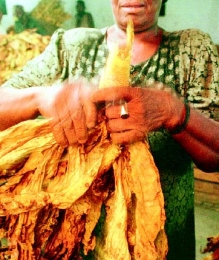Zimbabwe was hailed as Africa’s success story when it declared independence in 1980. The economy was growing and the country was among the most prosperous on the continent. Yet just 30 years later, the ‘bread basket of Africa’ is in a state of total economic collapse. How did it get to this, asks Viktor Posudnevsky.
“If I were told what would happen to my country when I was growing up there in the ’80s, I would have never believed it,” says Nobuhle Ncube, a Zimbabwean living in Ireland. “I never thought I would go abroad. At school I could map out my future in Zimbabwe. I knew what I wanted to do and I believed I’d be able to achieve that in my country.”
But the dreams and hopes of a whole generation of Zimbabweans were soon thwarted. By the time they had finished school there were no jobs for them, and prospects at home were getting increasingly slim. Yet up until the mid-1990s life was at least bearable.
“You could safely drink water from a kitchen tap,” remembers Tendai Madondo. “We’d hear of cholera outbreaks, but they always seemed to happen in other countries. Poor families could afford to have three meals a day, but now even the highest-paid are struggling.”
“Last time I visited my country was in 2004 and it was really bad,” remembers Johannes Nyawata, a social worker from Zimbabwe. “We used to have a very good health care system, one of the best in Africa. The numerous clinics are still there, but now they’re lying empty. And the ones that are functioning are charging prices which most people cannot afford.”
Socially unsustainable
It is not easy to pinpoint what exactly led to this downfall, but most observers agree that the blame lies with Zimbabwe’s long-time president Robert Mugabe and his government’s mismanagement of the country. Mugabe himself is quick to put the blame on “illegal” sanctions which countries like US and Britain have imposed on Zimbabwe. But the sanctions are actually targeting the assets of the political elite – the 120 or so generals and senior civil servants, including Mugabe, who are responsible for human rights abuses.
“I don’t believe international sanctions are to blame in any way,” says Dr Padraig Carmody of Trinity College Dublin. “They do not restrict companies from investing in Zimbabwe or doing business there.”
Dr Carmody has written a book about the collapse of the Zimbabwean economy and political repercussions arising from it, for which he spent a year researching in the southern African country.
“In the ’80s Zimbabwe’s economy was growing very vigorously on the back of agriculture,” he says. “Zimbabwe was the second largest tobacco exporter in the world and many other crops were exported.”
Technologically, the country’s agricultural sector was beyond competition in southern Africa. Crops were grown 12 months a year: six months naturally and the other six under intensive irrigation. “I remember how you would drive past a farm and see those big irrigation machines at work, watering beautiful crops of wheat,” says Andrew Furlong, who spent 11 years in Zimbabwe as a priest.
However, the large farms were all owned by white farmers, and this situation was “socially unsustainable”, argues Dr Carmody.
From the outset of independence there was a political will in Zimbabwe to redistribute the huge farms – owned by a small fraction of the population – among the black peasants, many of whom were leading subsistence-level lifestyles on small land plots. But this would come at a cost. Imagine dividing a 500-acre farm into 25 or 30 smaller farmsteads. First, new roads and possibly schools and clinics would need to be built. Secondly, the peasants did not have the expertise of the white farmers, and production was bound to decline as the whites left.
“At one stage you’d see huge farms which were lying empty,” remembers Furlong. “Their white owners had left after being intimidated by Mugabe’s supporters, but the government did not start the redistribution process because it was so complicated.”
In the end many of the farms were simply grabbed by generals and corrupt civil servants. Agricultural production plummeted, as did exports, leading to severe cash shortages in Zimbabwe.
Other areas would soon follow suit. Manufacturing – another sector propping up the country’s economy – experienced a similar decline. “Zimbabwe was the only country in the region, outside South Africa, to have integrated steelworks,” says Dr Carmody speaking of the country’s once highly developed industries.
Around 1990, Zimbabwe – which up to then favoured protectionist policies – fully opened its market to the outside world. Both the government and the World Bank, which oversaw this transition, believed that its strong manufacturing sector would cause the economy to bounce back.
“In fact, it slumped,” says Dr Carmody. “Zimbabwe could not compete with manufacturers like China and as soon as borders opened cheap imports flooded the market.” This led to the deterioration of Zimbabwe’s own industries.
But while key sectors of the economy were going into steady decline, the government continued to spend money like it owned a magic cornucopia, the mythical horn of abundance. “Whenever there was a shortage of cash, the government would just print more money,” says Dr Carmody. This reckless practice led to hyperinflation.
Spend like there’s no tomorrow
Throughout the 1980s Zimbabwe’s government spent colossal amounts of cash on building new schools and clinics, boring waterholes and recruiting public servants. According to the International Political Science Review, total spending on education and health tripled between 1979 and 1990, while expenditure on public sector employment rose by 60 per cent every year.
At the same time Robert Mugabe repeatedly sanctioned pension increases and large-scale lump sum payments to war veterans, the army and the police to keep them satisfied and loyal.
“In 1997 dissatisfaction grew among the war veterans,” says Dr Carmody. “When Mugabe was addressing them at a rally, they booed at him. He realised that his neck was on the line and that he would be overthrown if he doesn’t sort it out.
“Soon afterwards Mugabe announces huge pension increases for war veterans. The following day the value of the Zimbabwean dollar falls by 75 per cent: investors lost all confidence after such a huge hike in public expenses.”
Zimbabwe plunged further and further down the spiral, but in 1998 Mugabe’s government intervened in the civil war in Democratic Republic of Congo (DCR). In response, the international community cut off aid supplies, and the war drained billions of US dollars from Zimbabwe’s beleaguered exchequer. But the generals were happy – some of them took control of lucrative mines and grabbed yet more land.
After 2000 the real turmoil began as Mugabe embarked on a series of policies which scared off all remaining investors, and elicited condemnation from the rest of the world.
In the years since, which saw violent land-grabs and an operation that left hundreds of thousands homeless, Zimbabwe’s economy contracted by 40 per cent. The inflation rate shot up to one of the highest ever recorded, and there were chronic shortages of food, fuel and medicine. Gross domestic product dropped by 40 per cent, agricultural output declined by 51 per cent and industrial production fell by 47 per cent from 2000 to 2007, according to Zimbabwe-Situation.com.
The end is near?
“Mugabe is, politically, one of the most skilled survivors the world has ever seen,” says Dr Carmody. “But already there is a seeping away of his power base.” He refers to the frequent ‘car accidents’ which have lately occurred in Zimbabwe, resulting in the deaths of powerful officials. “Already there is a struggle, with some generals positioning themselves for the end of the Mugabe era.”
But for ordinary Zimbab-weans, Mugabe’s retirement, deposition or death does not spell the end of all their problems. “For me the biggest concern is economy,” says Nobuhle Ncube. “When Mugabe goes one problem will be solved, but many more will have to be addressed. What matters most for the people is how to rebuild the country.”












